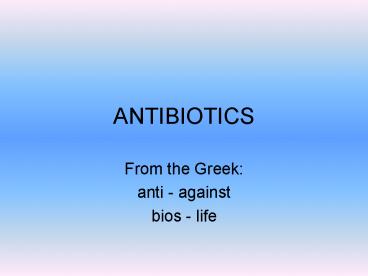ANTIBIOTICS - PowerPoint PPT Presentation
1 / 33
Title:
ANTIBIOTICS
Description:
... Sulfonamides Metabolite Inhibition Sulfonamide P-aminobenzoic acid Commonly used antibiotic types Penicillins Cephalosporins ... Mode of action is enzyme ... – PowerPoint PPT presentation
Number of Views:192
Avg rating:3.0/5.0
Title: ANTIBIOTICS
1
ANTIBIOTICS
- From the Greek
- anti - against
- bios - life
2
Chemotherapy
- Paul Ehrlich
- Use of chemical agent to kill bacteria and not
harm the host - Search for the Magic bullet
- Developed an arsenic compound that killed the
bacteria that causes syphilis - Compound was called salvarsan but was quite toxic
to the host
3
Antibiotics
- Natural compounds produced by microorganisms that
inhibit the growth of other microbes - Majority of antibiotics come from Streptomyces
bacteria and molds - Over 100 different antibiotics
- Antibiotics generally have two names
- Brand name created by the drug company
- Generic name based on the chemical structure or
class of antibiotics
4
Famous penicillin picture
5
Alexander Fleming
- Discovered penicillin by accident in 1928
- A mold contaminating a plate of Staphylococcus
aureus showed anti-bacterial properties - The mold was identified as a member of genus
Penicillum, hence the name for the naturally
produced antibiotic - Fleming won the Nobel prize in 1945 for this
discovery, shared with Howard Florey and Ernst
Chain
6
Penicillin
- Wonder drug
- Killed bacteria with few side effects on the
patient - SELECTIVE TOXICITY
- Penicillin was NOT the first anti-bacterial
compound - Penicillin was the FIRST natural compound that
kills bacteria - Antibiotic
- Not made in the lab
7
Spectrum of Activity
- Broad spectrum antibiotics
- Effect both G and G- bacteria
- Tetracycline
- Narrow spectrum antibiotics
- Effects fewer types of pathogens
- More selective?
- Penicillin best against G bacteria
8
How do antibiotics work?
9
Cell Wall Synthesis
- Penicillin
- Prevents synthesis of the peptidoglycan
components of the cell wall - Targets actively growing cells
- Very little toxicity to human cells
10
Inhibition of protein synthesis
- Broad spectrum of activity all bacteria have to
make proteins - Difference in ribosome size in bacteria accounts
for selective toxicity - Chloramphenicol, erythromycin (G), streptomycin,
tetracyclines
11
Injury to plasma membrane
- Changes to permeability of membrane causes loss
of metabolites - Polymyxin B
12
Inhibition of nucleic acid synthesis
- Inhibition if either DNA replication or mRNA
synthesis - Toxicity problems
- Rifampin mRNA blocker
- Nofloxacin and ciprofloxacin DNA synthesis
blockers
13
Inhibition of synthesis of essential metabolites
- Block enzyme activity
- Competitive inhibition of enzyme activity
- PABA (para-aminobenzoic acid) competition
- Sulfonamides
14
Metabolite Inhibition
- Sulfonamide
- P-aminobenzoic acid
15
Commonly used antibiotic types
- Penicillins
- Cephalosporins
- Animoglycosides
- Macolides
- Sulfonamides
- Fluoroquinolones
- Tetracyclines
- Polypeptides
16
Penicillin
- Destroys the cell wall of bacteria
- Best against G bacteria during active growth
- Examples
- Penicillin G
- Penicillin V
- Ampicillin
- Amoxicillin
17
Cephalosprorins
- Similar to penicillin - interferes with cell wall
formation - Used when patient is allergic to penicillin
- Examples
- Cefadroxil
- Cephapirin
- Cephalexin
- Cephalothin
18
Aminoglycosides
- Inhibition of protein synthesis in bacteria
- Some toxic reactions possible in kidney and liver
- Examples
- Gentamicin
- Streptomycin
- Neomycin
19
Macrolides
- Interfere with bacterial protein synthesis
- Commonly given to patients that are sensitive to
penicillin - Gastrointestinal discomfort is a common side
effect - Examples
- Azithromycin
- Erthromycin
20
Sulfonamides
- Very early antimicrobial substance
- Commonly called sulfa drugs
- Developed in the 1930s in Germany
- Mode of action is enzyme inhibition
- Allergy to sulfa is common
21
Fluoroquinolones
- Large class of semi-synthetic broad spectrum
antibiotics - Inhibition of bacterial DNA replication
- Few side effects, well tolerated
- Examples
- Ciprofloxacin
- Norfloxacin
22
Tetracycline Antibiotics
- Members of this group of antibiotics are produced
by Streptomyces group of bacteria - Inhibition of protein synthesis
- Used commonly to treat acne
- Examples
- Tetracycline
- Deoxycycline
23
Penicillin
24
Penicillinase
25
Cephalosporin and Penicillin
- Cephalosporin
- Produced from a fungus
- Similar in action to penicillin
- More active against G- bacteria
- More resistant to penicillinase
- Penicillin
- Produced from fungus
- Inhibits cell wall synthesis
- Effective against mostly G bacteria
- Penicillinase sensitivity
26
Cephalosporin and Penicillin
27
Adverse reactions
- Toxicity
- Allergy
- Disruption of natural flora
- Yeast infections
28
Antibiotic Resistance(A BIG problem)
- Resistance is acquired by mutation
- R (resistance) plasmids acquired by bacterial
conjugation - How to limit resistance
- Take all your pills, dont stop when you feel
better - Use antibiotics only when necessary
- NEVER take antibiotics for viral infection alone
29
Nosocomial Infections
- Infections acquired while in a health care
facilities - CDC estimates 2 million people per year get these
infections - 90,000 deaths per year
30
Nosocomial Infections
31
Antiviral Drugs
- Limited in number
- Targets for these drugs are viral reproduction
- Nucleotide analogs are the most commonly used
agents disrupt viral nucleic acid replication - Acyclovir
32
Nucleotide analog
33
Sensitivity Testing































